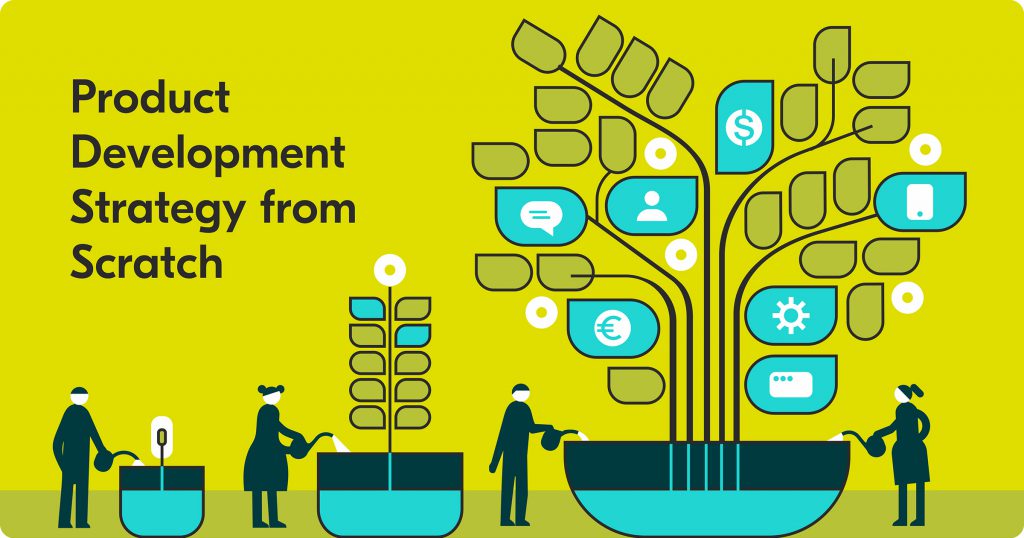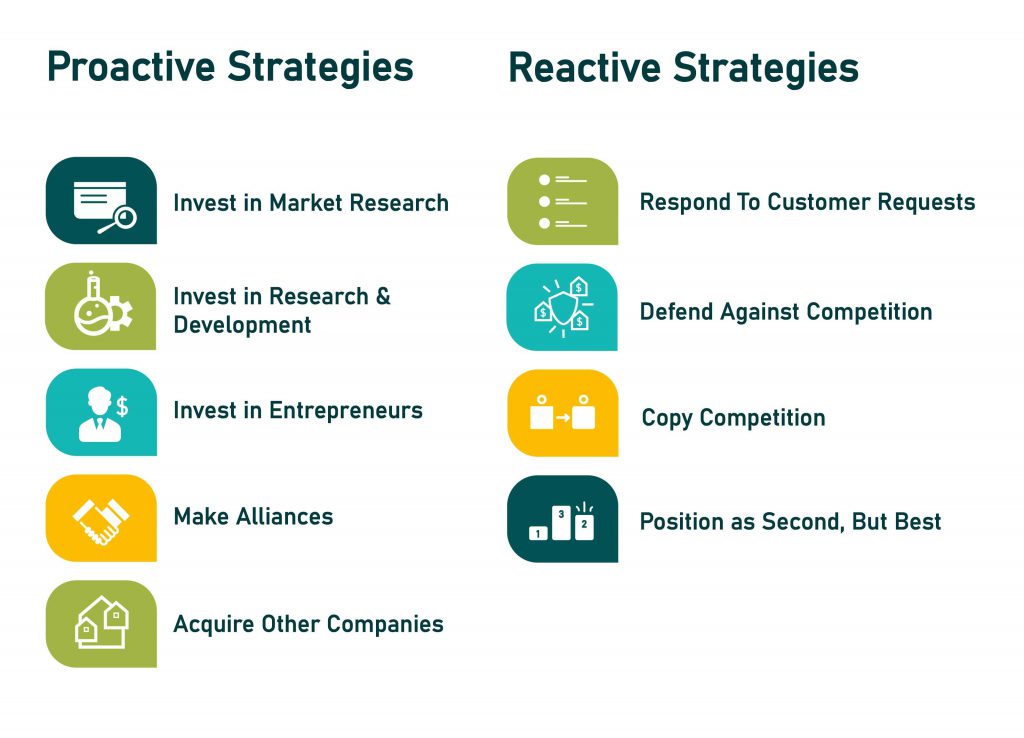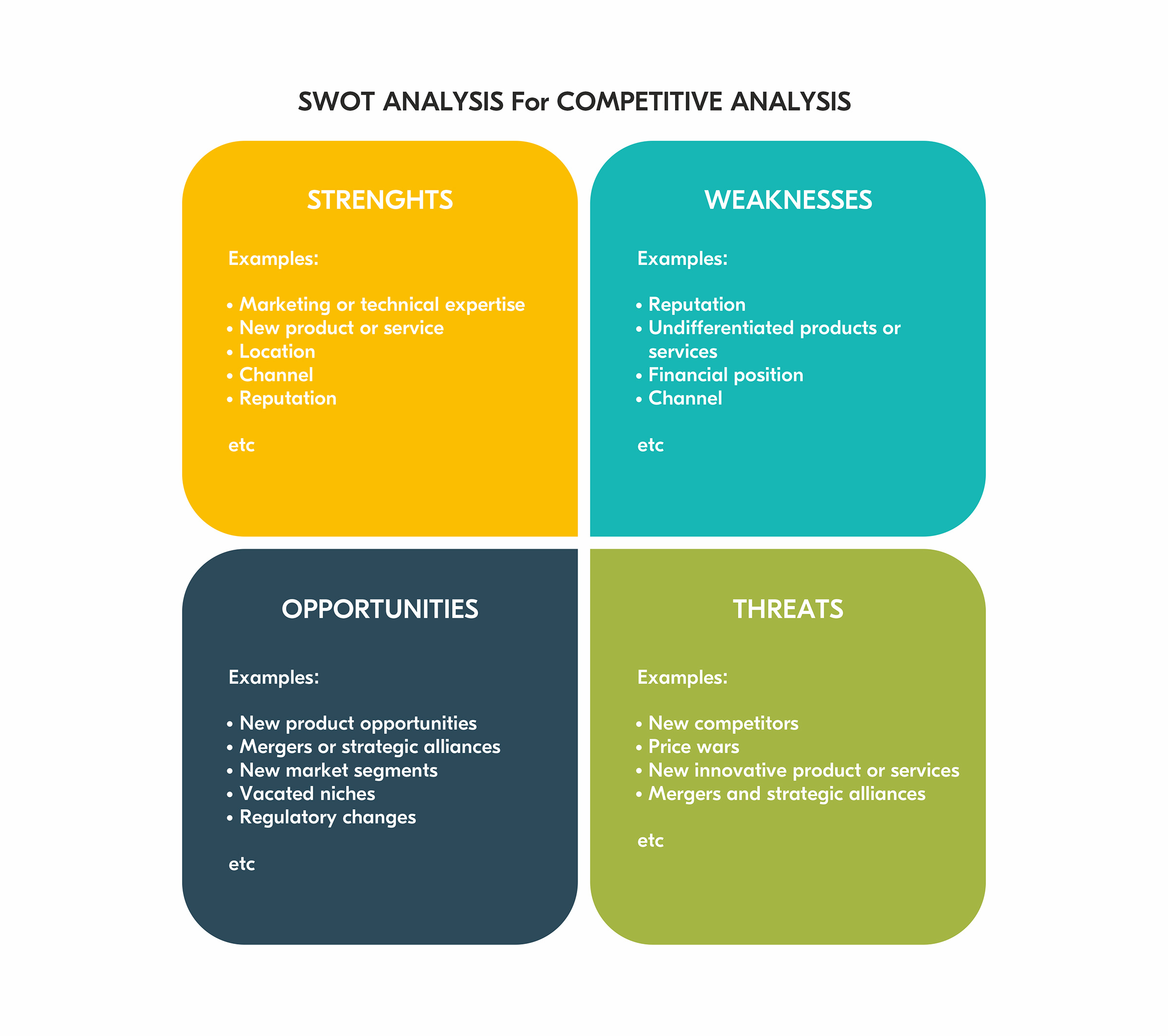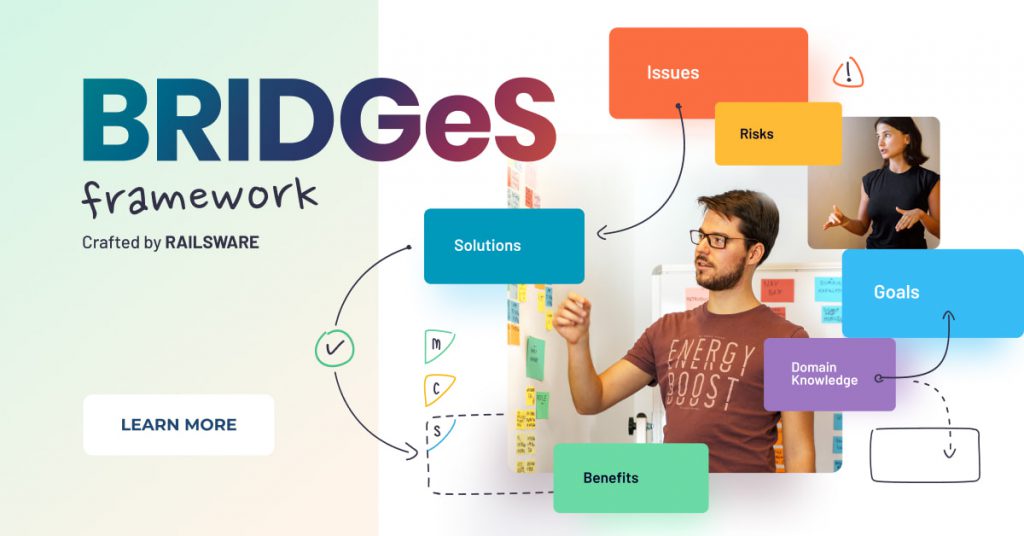
What is a Product Development Strategy?
A product development strategy is an inevitable part of a product development life cycle. It’s a set of actions aimed at bringing new products to an existing market, existing products to a new market, or new products to a new market. Still sounds unclear?
To have a complex understanding of what a product development strategy is and why you need one, we have to also be familiar with such notions as product vision and product development roadmap, as these three terms often are used interchangeably.
Product vision is an idea of why the product should exist. It describes the essence of the product and explains the bigger picture for everyone who is or going to be anyhow connected with it. Here are the examples of some famous product visions:
- Google: “To provide access to the world’s information with one click.”
- IKEA: “To create a better everyday life for the many people.”
- Instagram: “To capture and share the world’s moments.”
- Uber: “Evolving the way the world moves.”
- Tesla: “To accelerate the world’s transition to sustainable energy.”
Product vision explains the dream behind it but doesn’t explain how this dream will become a reality. This is where a product development strategy comes in handy. A product development strategy defines how to achieve the vision behind the product without getting too deep into details (we have a product development roadmap for that).
The task of the product development strategy is not only to explain what to build but also to emphasize what not to build as some hypotheses can seem quite appealing but may appear non-related to the product vision. In this case, product development strategy allows focusing on the final goal and spending the resources accordingly.
When a product development strategy is ready, it can be broken down into milestones which will be transformed into product roadmaps with clearly defined duty holders and estimated timeframes. A roadmap can change depending on the market situation, technologies and specialists available in the team, and many other factors. Nevertheless, it should always correlate with the product strategy and vision that are fixed and rarely deviate.
For more insight nuggets on strategy and tracking product performance, we encourage you to check out our SaaS product management handbook.
Here’s a basic example of how these three aspects relate to each other:
| Vision | Strategy | Roadmap |
|---|---|---|
| Have a great beach holiday | Self-organize a trip to Punta Cana | Take a flight from Kyiv to Santo Domingo, Dominican Republic, then rent a car and drive to Punta Cana. Rent an apartment there. |
You can think of several roadmaps and choose the one that suits your objectives best. At the same time, the vision and strategy have to be permanent. Otherwise, it would be impossible or very difficult to achieve. Plus, you’ll waste a lot of resources. Just imagine you’re heading to Punta Cana and decide to go to Vietnam halfway.
Here’s another example ‒ Netflix
| Product Vision | Product Strategy | Product Roadmaps |
|---|---|---|
| Become the best global entertainment distribution service. | Focus on original content, personalization, watching experience, interactive storytelling. |
Reasons to create a product development strategy
Some startups ignore product development strategies and make do with a roadmap. However, product strategy brings a number of considerable benefits that make it a valuable tool to guide development and business in general. Here are some of them:
- Better team alignment during the development process. One of the most common issues that emerges during the product development process is reworks due to misunderstandings. To be able to release a product on time, the team must set up efficient communication so that all team members are on the same page and know where to head. A product development strategy, in this case, is a useful tool to remind the team what’s the point of the final destination no matter what roadmap they choose.
- Risk mitigation. With a product development strategy, a team gets more chances to create a product you want and users need. The strategy should be based on in-depth research of the target audience, market, competitors, etc. This way, you eliminate guesswork and pave the way for a true data-driven development process.
- Resource saving. As we mentioned before, product development strategy explains what to build and what not to build. The team doesn’t spend resources on increments that don’t relate to the product development strategy and vision of the product. Such laser focus minimizes the time to market for your product.
Now that you know what a product development strategy is and why you need one, let’s look at the types of strategies you can choose for your product.

Types of product development strategies
In 1980, Glen L. Urban and John R. Houser released a book where they defined nine product development strategies, divided into proactive and reactive categories.

Proactive strategies
Companies that use proactive product development strategies have way more chances to make a technological or scientific breakthrough. Here is what these companies do:
- Invest in market research. Companies that rely on this approach investigate modern market conditions, including customers and their needs, trends, and tendencies, dominant and smaller market players. Such in-depth analysis and research helps to gain valuable insights and detect hidden opportunities for new products.
- Invest in research and development. When creating in-house or even offshore R&D hubs, companies make long-term investments in innovation and technology. This strategy is aimed at making discoveries that can be used in new products to provide its creators with a significant competitive advantage and market leadership.
- Support in-house pet projects. This approach is also called investment in entrepreneurship and means boosting entrepreneurial spirit within the team to generate new ideas and approaches to product development. The strategy is actively used by Google, which allows (and encourages) its workers to allocate 20% of their work time to personal projects that may have no relation to what employees do another 80% of work time. As a result of such an experiment, Google released Gmail and AdSense, which now bring incredible revenue.
- Make alliances. The strategy implies cooperation with companies from other industries. Such cooperation allows partners to create unique experiences for end-users that are very difficult to replicate. If you need an example, think of an alliance between Uber and Spotify in 2014 when Spotify users with premium accounts could listen to their favorite music in Uber. Some companies in complex industries like fintech, for example, prefer to use white-label fintech solutions with access to source code, enabling their development teams to customise and launch products faster while reducing time to market.
- Acquire other companies. The strategy is based on detecting promising (often competitive) companies and acquiring them to make a part of their service/product line. This is what happened to Instagram when Facebook acquired it in 2012.
Reactive strategies
Companies using reactive product development strategies respond to the changes in the market and focus on adjusting their products so that they can compete with others. Here is what these companies do:
- Respond to customer’s requests. This strategy can be used to improve an existing product or develop a new one based on the customers’ feedback. The strategy helps to keep good relationships with the customers. However, companies that rely on this strategy may come up with a solution too late.
- Defend against the competition. The defensive strategy puts companies in a position when they have to compromise on some aspects of their offers to keep afloat. Usually, they decrease the price, reduce the functionality of their offers (to keep the price low), invest in advertising more, change their targeting, etc.
- Copy competitors. When a paradigm-shifting product hits the market and becomes paramount, competitors copy the idea and flood the market with clones. The strategy can be very promising if a copy is released in a territory where the original product hasn’t been released yet. Thus, the clone could gain more popularity than the original product.
- Position as second, but best. This strategy is similar to the previous one, however, the original product is not copied completely but is improved or modified. The approach allows companies to detect weaknesses of the original product or use opportunities that the first company missed to release a better product.
Key steps when creating a product development strategy
Perform research
A product development strategy shouldn’t be built in a vacuum, so before you start working on it, you need to investigate the surrounding the product is going to exist in. Start with:
Customer research
Even if you create a development strategy for an existing product and know who your customers are, it’s important to undertake a study again as it can help you detect even slight changes in customers’ mood and behavior. This is where effective client management software can be invaluable, enabling you to continually monitor and adapt to evolving customer needs and preferences.
Competitor research
To be able to create a value proposition that sets you apart from your competition and always puts you one step ahead, you need to know the offers of your rivals. This study can also help you detect the weaknesses of your competitors and opportunities they didn’t use.
You can analyze a competitor with the help of a SWOT analysis. SWOT stands for Strengths, Weaknesses, Opportunities, and Threats. Use it to analyze your competitors’ products to learn how they are surviving in the market.

Market and macro environment research
The macro environment or, in other words, all the economic, technological, political, and cultural factors that may affect your product and industry, both long- and short-term. This research allows you to detect aspects that can influence your product development strategy significantly, such as:
- New markets where your product may attract new audiences
- Emerging technologies that may influence your users or customers
- The economy with all its factors that can impact your customers’ budgets
- The ever-changing customer needs and behaviors
Form your business model
Companies are expected to make money and meet return on investment (ROI) goals. To create an effective product strategy, you need to agree on how your product or service will earn money and achieve your business goals.
There are a lot of options to choose from, such as subscription, freemium, advertising, commercial partnerships, etc. The choice of a business model for your product should be based on its type, customers’ preferences, and market conditions. If your product is totally new, it may be sensible to choose the strategy when users don’t have to pay for using it (e.g., advertising, partner ads). If your product has already proved its value, you can adopt a model where users pay for using it (e.g., subscription, freemium, etc.)
Set SMART goals
When setting specific, measurable, achievable, realistic, and timely goals for your product, you get a simple tool to measure its success. More than that, you may also get a vector for your product or service development.
Imagine you have an existing product, and your goal is to attract 100 new users a month from a teenage audience. As a strategy direction, you may perform UX and UI audits and redesign your product to make it more attractive for youngsters.
Define actionable metrics to track
Your product and its users generate tons of data analyzing which, you can get valuable insights. However, not all data is equally important. Some metrics are non-informative. They are called vanity metrics. To find out the real results of your product, you need to define actionable metrics to track. These metrics are different for each product.
Go the extra mile and create a product dashboard to help you and your team visualize the relevant data – we explain how, and more on why, to do this on a separate article.
For example, for a free Android app that uses ads as a monetization strategy, the number of downloads and installs isn’t very informative, even if the number is large. In this case, it’s better to track the number of active daily and monthly users. Whereas for a paid iOS app, the number of installs is an actionable metric, as every download brings revenue.
Define the development strategy
To form a product development strategy for your product, you need to process all the collected data from the previous steps. Every piece of data matters, so you should find an approach that will allow you to successfully sort, organize, and process the data. At Railsware, we apply the BRIDGeS framework for these purposes. You’ll find more details on this framework below.
Create a development roadmap
When the strategy is clear and the actionable metrics are defined, it’s time to map the most sensible road to get to the final destination. A product development roadmap includes the main development milestones that lead to the product release. To get more details on the topic, check out our guide on a product roadmap and how to create one.
For more guidance on how to set achievable goals, tackle customer research, and choose product metrics, check out these product management frameworks.
Best practices when developing a product strategy
If you’re creating a product development strategy for the first time, you may follow some best practices to avoid common pitfalls and mistakes.
#1. Stay in touch with your customers
Make your product development strategy customer-driven and include regular customer surveys to gain more insights that can help you guide your strategy in the right direction.
Listening carefully to what customers say can give you a strong competitive edge. Of course, you don’t want to act on every single opinion. However, identifying and responding to those that are repetitive can only help you.
#2. Keep the speed–quality balance
When releasing a new product, service, or feature to the market, it’s critical to be fast. This is why you need to keep the balance between the development speed and quality of your product. You can opt for a minimum viable product (MVP), which allows you to reduce time to market, focusing only on those features that meet customers’ biggest needs.
There are other options for testing your product, depending on your needs and goals, so make sure to explore them in our MVP vs prototype vs PoC guide.
#3. Use the hype of testing new products
Every time October clocks in, we witness the never-ending lines of people anxious to buy their new iPhone that just came out. This is exactly the kind of attitude consumers have when a brand they trust announces a new product launch. People want to test new products of a brand that innovates along with their needs and desires.
#4. Neglect some feedback
While it’s critical to collect customers’ opinions, you’d better take them with a pinch of salt, because you can’t respond to all of them. Also, customers’ tastes and desires may and most likely will change before you know it. As a result, you may end up with a product that people are no longer interested in. To avoid that, it’s good to shorten the time span for your strategy and get products to market while they are still in high demand.
#5. Set realistic goals
Without sufficient market research and quality benchmarks in place, the team may set expectations that the product can’t meet. When this happens, the team can’t break down the strategy to milestones and work out realistic roadmaps.
Railsware experience in product development strategy
For Railsware, product vision, development strategy, and roadmap are the interdependent terms that we consider from a holistic perspective. For many years, since there was no multi-purpose tool that let us work on several subjects and contexts simultaneously, we had been using different strategy-building and product discovery tools and approaches.

Our search led us to the Pivotal Labs and their Inception approach for product validation. We took it as a base, improved, and tested it in different conditions. This gave rise to a new unified concept: BRIDGeS.
The BRIDGeS framework is a straightforward instrument for product discovery that lets us form a product vision, development strategy, and even roadmap. Having been practicing BRIDGeS with our clients and applying it to our product development, we are now convinced of its efficiency and versatility.
Among the most significant advantages that the framework has are:
- Versatility, as you can apply it to any type of subject and any purpose.
- Reversibility, as you can analyze discovered solutions through BRI over and over again until you find the optimal solution.
- Simplicity, as the framework doesn’t involve any complex notions or processes.
- Added value, as you get not only the solution but a development roadmap as well.
Check out a detailed description of how to run an effective BRIDGeS session, or subscribe to our Youtube channel.
Examples of product development strategies
To demonstrate to you what product development strategies for different products may look like, let’s start with the ones built by our team.
Mailtrap
Mailtrap is an online tool for safe email testing in dev and staging environments. It’s popular among developers as it’s an easy instrument to catch test emails, view them in virtual inboxes, and modify (debug) before the real mailout. The product was created for the needs of our team and grew to a fully-fledged commercial project with thousands of active users.
For Mailtrap, we chose a proactive product development strategy ‒ investing in research and development. We’re constantly working on innovations and looking for brand new approaches to attract new users and make Mailtrap even more efficient. For that, we:
- Post educational materials to acquire users. We use our blog and other media to promote the existing features of the product. We explain how it handles tasks beyond the principal function and educate our audience about the industry in general.
- Regularly audit UX/UI to improve retention. We iteratively check the user experience and interface design of the product to make sure that it feels intuitive and looks great. This is our key strategy to retain customers.
- Add features for the enterprise sector. To acquire a new type of users (enterprises), we add features that can solve their issues connected with security, user management, and legal aspects.
Smart Checklist for Jira
Smart Checklist for Jira allows teams to be more productive using a simple yet feature-packed checklist. The first version of the add-on was created to cover the needs of our team. It contained the bare minimum of functionality to prove the idea’s viability and to fulfill the principal function absent on the market at that time ‒ create a checklist using Markdown formatting that would integrate with Jira via API.
Today, the product offers its users a high level of customization and tons of functionalities. Yet, it’s an add-on and its market is limited with Jira Atlassian users. As the product is actively growing on its own, there is no need to invest heavily in research and development, or making alliances with other companies. This is why we focus more on the reactive strategy and modify Smart Checklist as a response to customer requests. Here’s what we do:
- Cooperate with Atlassian on guest posting. We also utilize Atlassian’s marketing offerings and community groups to increase awareness of the product.
- Constantly improve user experience and user interface and maintain excellent documentation to provide effortless setup and enable fast user activation.
- Collect users’ feedback to ensure we’ve covered all their needs and that our product has become an integral part of their daily Jira experience. Provide exceptional customer service to keep the retention level high and encourage users to recommend our Smart Checklist for Jira to their friends and colleagues.
- Extend product offering from Jira Cloud to Server/Data Center, perform regular CustDev sessions that result in extending feature sets and ample integration possibilities to increase revenue.
Coupler.io
Coupler.io is a Google Sheets add-on to pull data from various apps to Google Sheets, Excel, BigQuery, and other destinations. The product development and growth strategy for Coupler.io consists of the following aspects:
- Release of new integrations to target new markets. Our team is steadily working on adding new integrations to make Coupler.io even more versatile and attractive for new users. We allocate separate resources for that no matter what other team members are working on.
- Introduction of large features to penetrate the existing market. The tool offers a bunch of features, and we frequently release new ones to get an even larget market share.
- UX improvements to keep retention. We believe our product should look and feel modern. We audit the UX of Coupler.io with fixed frequency and improve it to ensure smooth operation and a seamless user experience.
- Constant market research. As a part of the proactive development strategy, our team tests various hypotheses utilizing the blog. We track topic popularity, embed polls and surveys to blog text, and encourage customers to set up live calls to share their experience in exchange for our help with their data problems.
And here are the examples of product development strategies of some famous products:
Microsoft
Microsoft Corporation is a technology giant founded by Bill Gates back in 1975. While the company has always invested heavily in Research & Development, it is also well known for acquiring a number of promising products, like Nokia, Skype, GitHub, Slack, Linkedin, and many others.
Virgin Hyperloop
Virgin Hyperloop is an American transportation company that uses Research & Development to make their revolutionary vacuum trains a reality.
Atlassian
Atlassian Corporation Plc is an Australian software company that supports its in-house pet projects similarly to Google. Such a development strategy resulted in major improvements, a list of new features in Jira, Bamboo, Confluence, and dozens of new add-ons on the Atlassian Marketplace.
Wrapping up
There is no one-size-fits-all strategy that works for everyone. Yet, every product development strategy should always start with comprehensive research. You need to go through the in-depth study and use all the data gathered to build a strategy that will distinguish your brand from competitors and help you become a market leader.